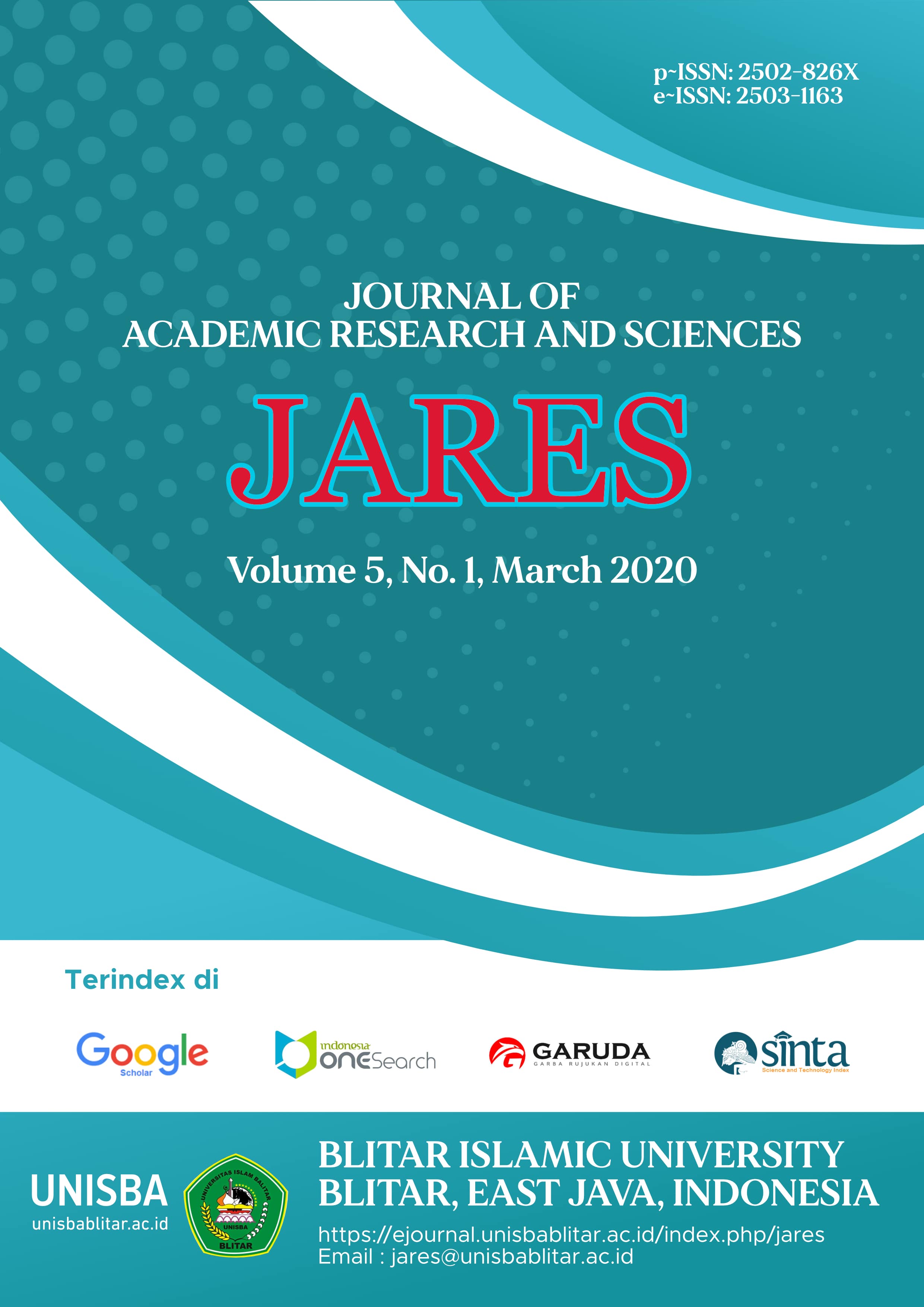WHY ISLAM IS THE WORLD FASTEST GROWING RELIGIOUS GROUP DESPITE OF TERRORISM ISSUES? AN INITIAL RESEARCH OF TERRORISM ISSUES AND ISLAM AWARENESS
Abstract
Pew Research Center reported that Islam is the fastest-growing religious group in the world compared to another religious group. The research mentioned that in 2050 Islam population will be 30% of world’s population while Christian will be silghtly more, 31% of world’s population therefore PEW Research Center predicted that in 2100 Islam population will lead religious group’s population even Christian. Terrorism news, extrimist and radical moslem group and Islamophobic culture almost in every western media platforms that rationally contradictory of reality that Islam is the fastest growing religious group. This research is to analyse terrorism issues in mass media and world’s Islam population. Research conducted in qualitative descriptive by literature research methode. The results of the research showed that despite of negative stereotypes in media who tend to correlated Islam and radical moslem group through several platforms such as movie and news, the decision to join Islam was uninfluenced. The stereotypes in news and movies about terrorism, radical moslem group, and extrimist in media could become an initial point for someone to dig information about Islam although it could not concluded as a pure motivation to join Islam.
Downloads
References
[2] Alonzo, Amalia. (2014). Latinas Converting to Islam in New York: Habitus’ Influence in Modern Identity Formation. CUNY Academic Works. Retrieved from https://academicworks.cuny.edu/gc_etds/161.
[3] Alyedreessy, Mona. (2016). British Muslim Converts: An Investigation of Conversion and De-Conversion Processes to and from Islam (Doctoral dissertation). Kingston University, London, England.
[4] Awan, Akil N. (2011). Conversion to Islam in Contemporary Britain: Motivations,processes and Consequences (Doctoral Dissertation). University of London, UK.
[5] Awang, Azarudin, Khadijah Mohd Khambali, Hambali. (2015). A Study on Factors that Encourages Chinese Muslim Community within Dialogue of Life. Journal of Basic and Applied Scientific Research. 5:1. Pp 45-53.
[6] Bartoszewicz, Monika Gabriela. (2013). Controversies of Conversions: The Potential Terrorist Threat of European Converts to Islam (Thesis). Retrieved from http://research-repository.st-andrews.ac.uk/.
[7] Bawer, Bruce. (2006). While Europe Slept: How Radical Islam Is Destroying the West from Within. Doubleday, New York.
[8] Becker, Carl H. (1924-1932). Islamstudien, 2 vols. Leipzig.
[9] Bowen, Patrick D. (2009). Conversion to Islam in the United States: A Case Study in Denver, Colorado. Intermountain West Journal of Religious Studies. 1:1, pp. 41-64.
[10] Brice M.A.K. (2010). A minority Within a Minority: A Report on Converts to Islam in the United Kingdom. Faith Matters Report.
[11] Brice, M. A. Kevin. (2010). A Minority Within A Minority: A Report On Converts To Islam in The United Kingdom. Faitth Matters. UK.
[12] Bulliet, Richard W. (1979). Conversion to Islam in the Medieval Period: An Essay in Quantitative History. Cambridge, MA.
[13] Caldwell, Christopher. (2009). Reflections on the Revolution in Europe: Immigration, Islam, and the West. Doubleday, New York.
[14] Congressional Research Service. (2011, September 7). Muslims in Europe: Promoting Integration and Countering Extremism. Retrieved from http://www.crs.gov.
[15] Danios. (2011, August 7). Surveys Show Muslims in Every Country Less Likely to Justify Killing Civillians than Americans and Israelis. Loonwatch. Retrieved from http://www.loonwatch.com/2011/08/surveys-show-muslims-in-every-country-less-likely-to-justify-killing-civilians-than-americans-and-israelis/.
[16] Eaton, Richard M. (1996). The Rise of Islam and the Bengal Frontier 1204 – 1760, 1st Edition. University of California Press, USA.
[17] Esseissah, Khaled. (2011). The Increasing Conversion to Islam Since 9/11: A Study of White American Muslim Converts in Northwest Ohio (Thesis). Bowling Green State University, USA.
[18] Friedersdorf, Conor. (2011, August 3). A Fascinating Look at the Political Views of Muslim Americans. The Atlantic. Retrieved from https://www.theatlantic.com/politics/archive/2011/08/a-fascinating-look-at-the-political-views-of-muslim-americans/242975/
[19] Geaves, R. (2010). Islam in Victorian Britain: The Life and Times of Abdullah Quilliam. Leicester: Kube Publishing.
[20] Hanggoro, Marcheilla Ariesta Putri. (2016, February 2). 5 Negara ini umat Islamnya bertambah paling cepat sedunia. Merdeka Com. Retreived from https://www.merdeka.com/.
[21] Harms, E. (1962). Ethical and Psychological Implications of Religious Conversion. Review of Religious Research. 3:3, pp. 122-131.
[22] Hasin, Atabik. (2015). Masuk Islam karena Alasan Perkawinan: Studi Kasus Perkawinan Pasangan yang Semula Beda Agama di Desa Borangan Kecamatan Manisrenggo Kabupaten Klaten (Undergraduate Thesis). Universitas Islam Negeri Walisongo Semarang, Indonesia.
[23] Holland, Joshua. (2015, December 2). Here’s What a Man Who Studied Every Suicide Attack in the World Says About ISIS’s Motives. The Nation. https://www.thenation.com/article/heres-what-a-man-who-studied-every-suicide-attack-in-the-world-says-about-isiss-motives/
[24] International Centre for Muslim and non-Muslim Understanding. (2015, 1 June). Australian Muslims: A Demographic, Social and Economic Profile of Muslims in Australia 2015. University of South Australia, Australia.
[25] Kearns, Erin M. and Betus, Allison and Lemieux, Anthony. (2017). Why Do Some Terrorist Attacks Receive More Media Attention Than Others? Retrieved from https://papers.ssrn.com/sol3/papers.cfm?abstract_id=2928138.
[26] Köse A. (1996). Conversion to Islam: A Study of Native British Converts. London: Kegan Paul International.
[27] Kumpoh, Asiyah az-Zahra Ahmad. (2011). Conversion to Islam: The case of the Dusun ethnic group in Brunei Darussalam (Doctoral dissertation). University of Leicester, UK.
[28] Lam, Joy Y. (2004, November). Religious Conversion and Reconstruction of Identities: The Case of Chinese Muslim Converts in Malaysia. Southeast Asia Research Center Working Paper Series. No 74. Retrieved from http://www.cityu.edu.hk/searc.
[29] Lofland, J. and Skonovd, N. (1981). Conversion Motifs. Journal for the Scientific Study of Religion. 20, pp. 373–385.
[30] Long T. E. & Hadden, J. K. (1983). Religious Conversion and the Concept of Socialization: Integrating the Brainwashing and Drift Models. Journal for the Scientific Study of Religion. 22:1, pp. 1-14.
[31] Mistiaen V. (2013, October 11). Converting to Islam: British Women on Prayer, Peace and Prejudice. The Guardian. http://www.theguardian.com/world/2013/oct/11/islam-‐converts-‐british-‐women-‐prejudice.
[32] Moosavi L. (2013, May 24). Are Converts More Likely to be Extremists than Other Muslims? The Guardian. http://www.theguardian.com/commentisfree/belief/2013/may/24/islam-converts-woolwich-attackers-extremists.
[33] Neumueller, Caroline. (2012). The 21st Century New Muslim Generation Converts in Britain and Germany (Doctoral dissertation). University of Exeter, UK.
[34] Nikmah, Laili Ilmi. (2013). Peran Majelis Muhtadin Al-Falah dalam Membimbing Muallaf di Masjid Al-Falah Surabaya Tahun 2009 (Undergraduate Thesis). UIN Sunan Ampel Surabaya, Indonesia.
[35] On Islam. (2014). Why I Chose Islam?: Stories About New Muslims’ Journeys to Islam. Retrieved from http://www. OnIslam.net. pp 9-12.
[36] Özyürek, Esra. (2015). Being German, Becoming Muslim: Race, Religion and Conversion in the New Europe. Princeton University Press, Princeton and Oxford.
[37] P. Bergen and E. Schneider. (2014, September 26). Bergen Schneider: How Many Jihadits. CNN. http://us.cnn.com/2014/09/26/opinion/bergen-schneider-how-many-jihadists/index.html
[38] Pargament, K. I. (1997). The Psychology of Religious Coping: Theory, Research, Practice. New York: Guilford Press. P 32.
[39] Pew Research Center. (2015, April 2). The Future of World Religions: Population Growth Projections, 2010-2050. Retrieved from www.pewresearch.org.
[40] Poole, E. (2002). Reporting Islam: Media Representations of British Muslims. London: I B Taurus.
[41] Priest, Chinyere.F. (2018). Conversion to Islam: A Study of Igbo Christians to Islam [Presentation Slides from 8th Lausanne International Researchers’ Conference, APRIL 30 TH – MAY 5]. Retrieved from http://www.globalcmiw.org.
[42] Puspito, Hendro. (1984). Sosiologi Agama, Cet. Ke-2.. Yogyakarta: Kanisius.
[43] Rambo, L. (1993). Understanding Religious Conversion. New Haven, CT: Yale University Press.
[44] Rieff, David. (2010, January/February). Fermez la Porte: The Oversimplification of Europe. World Affairs. Retrieved from http://www.worldaffairsjournal.org/article/fermez-la-porte-oversimplification-europe.
[45] Roald, Anne Sofie. (2004). New Muslims in the European Context: The Experience of Scandinavian Converts. Brill, Leiden.
[46] Rogozen-Soltar, Mikaela. (2012). Managing Muslim Visibility: Conversion, Immigration, and Spanish Imaginaries of Islam. American Anthropologist. 114:4. pp 611-623.
[47] Salaymeh, Lena. (2016). Taxing Citizens: Socio-legal Constructions of Late Antique Muslim Identity. Islamic Law and Society. 23:4, pp. 333-367.
[48] Schuurman, B., P. Grol and S. Flower. (2016). Converts and Islamist Terrorism: An Introduction. The International Centre for Counter-Terrorism – The Hague. 7:3.
[49] Shahid, Muhammad Haneef. (1999). Yes! I Converted to Islam and here is Why?. Darussalam. New York, USA. pp 11-12.
[50] Simonsohn, Uriel. (2013). Conversion to Islam: A Case Study for the Use of Legal Sources. History Compass. 11: 8, pp. 647–662.
[51] Simonsohn, Uriel. (2017). Conversion, Exemption, and Manipulation: Social Benefits and Conversion to Islam in Late Antiquity and the Middle Ages. Medieval Worlds. No. 6, pp. 196-216. DOI 10.1553/medievalworlds_no6_2017s196.
[52] Straus, R. A. (1979). Religious Conversion as a Personal and Collective Accomplishment. Sociological Analysis. 40:2, pp. 158-165.
[53] Sturm, Nika. (2017). Northwest European Female Conversion to Islam and Conceptualization of Prejudices, Discrimination and “Otherness”. Uppsala University, Sweden.
[54] Suleiman Y. (2013). Narratives of Conversion to Islam in Britain: Female Perspectives. Cambridge: Cambridge University.
[55] Tausch, Arno. (2017, September 25). How Many Muslims Still Support Terrorism?. Telospress. Retrieved from http://www.telospress.com/.
[56] Taylor J. And Morrison S. (2011, January 4). The Islamification of Britain: Record Number Embrace Muslim Faith. The Independent Tuesday. http://www.independent.co.uk/news/uk/home-‐news/the-‐islamification-‐of-‐britain-‐record-‐numbers-‐embrace-‐muslim-‐faith-‐2175178.html.
[57] Taylor, D. (1999). Converting: Inward, Outward and Awkward. In: C. Lamb and D. Bryant, eds, Religious Conversion: Contemporary Practices and Controversies. London and New York: Cassell, pp. 35–45.
[58] Vaisse, Justin. (2010, January 4). Eurabian Follies. Foreign Policy. Retrieved from https://foreignpolicy-com/2010/01/04/eurabian-follies/
[59] Vroon-Najem, Vanessa. (2014). Sisters in Islam: Women’s Conversion and the Politics of Belonging: A Dutch Case Study (Doctoral dissertation). Amsterdam Institute for Social Science Research, Netherlands.
[60] Why are So Many Westerners Converting to Islam?. (2015, July 14). CBN. Retrieved from http://www1.cbn.com/spirituallife/why-are-so-many-westermers-converting-to-Islam.
[61] Zebiri, Kate. (2014). British Muslim Converts: Choosing Alternative Lives. New York: Oneworld Publications.
[62] Zygmunt, J. F. (1972). When Prophecies Fail. American Behavioral Scientist. 16:2, pp. 245-268.

Copyright (c) 2020 JARES (Journal of Academic Research and Sciences)

This work is licensed under a Creative Commons Attribution-ShareAlike 4.0 International License.
Authors who publish with this journal agree to the following terms:
- Copyright on any article is retained by the author(s).
- Author grant the journal, right of first publication with the work simultaneously licensed under a Creative Commons Attribution License that allows others to share the work with an acknowledgement of the work’s authorship and initial publication in this journal.
- Authors are able to enter into separate, additional contractual arrangements for the non-exclusive distribution of the journal’s published version of the work (e.g., post it to an institutional repository or publish it in a book), with an acknowledgement of its initial publication in this journal.
- Authors are permitted and encouraged to post their work online (e.g., in institutional repositories or on their website) prior to and during the submission process, as it can lead to productive exchanges, as well as earlier and greater citation of published work.
- The article and any associated published material is distributed under the Creative Commons Attribution-ShareAlike 4.0 International License






